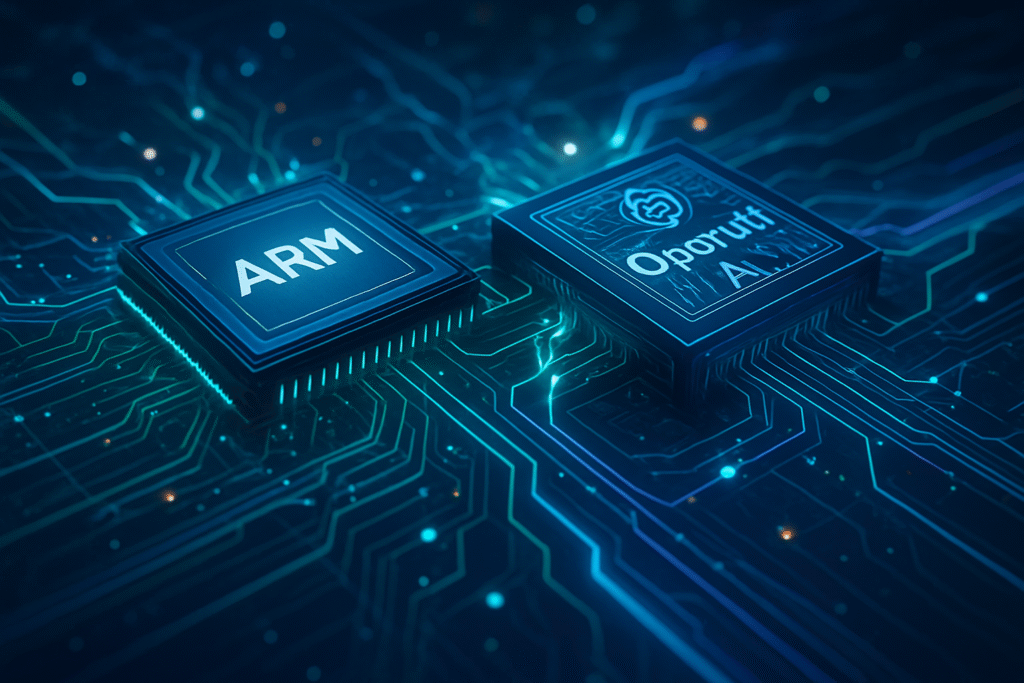OpenAI and Arm Forge Alliance to Reshape AI Chip Landscape

In a groundbreaking strategic move set to redefine the future of artificial intelligence infrastructure, OpenAI, the leading AI research and deployment company, has embarked on a multi-year collaboration with Arm Holdings PLC (NASDAQ: ARM) and Broadcom Inc. (NASDAQ: AVGO) to develop custom AI chips and advanced networking hardware. This ambitious initiative, first reported around October 13, 2025, signals OpenAI's determined push to gain greater control over its computing resources, reduce its reliance on external chip suppliers, and optimize its hardware stack for the increasingly demanding requirements of frontier AI models. The immediate significance of this partnership lies in its potential to accelerate AI development, drive down operational costs, and foster a more diversified and competitive AI hardware ecosystem.
Technical Deep Dive: OpenAI's Custom Silicon Strategy
At the heart of this collaboration is a sophisticated technical strategy aimed at creating highly specialized hardware tailored to OpenAI's unique AI workloads. OpenAI is taking the lead in designing a custom AI server chip, reportedly dubbed "Titan XPU," which will be meticulously optimized for inference tasks crucial to large language models (LLMs) like ChatGPT, including text generation, speech synthesis, and code generation. This specialization is expected to deliver superior performance per dollar and per watt compared to general-purpose GPUs.
Arm's pivotal role in this partnership involves developing a new central processing unit (CPU) chip that will work in conjunction with OpenAI's custom AI server chip. While AI accelerators handle the heavy lifting of machine learning workloads, CPUs are essential for general computing tasks, orchestration, memory management, and data routing within AI systems. This move marks a significant expansion for Arm, traditionally a licensor of chip designs, into actively developing its own CPUs for the data center market. The custom AI chips, including the Titan XPU, are slated to be manufactured using Taiwan Semiconductor Manufacturing Company Limited (NYSE: TSM) (TSMC)'s advanced 3-nanometer process technology, featuring a systolic array architecture and high-bandwidth memory (HBM). For networking, the systems will utilize Ethernet-based solutions, promoting scalability and vendor neutrality, with Broadcom pioneering co-packaged optics to enhance power efficiency and reliability.
This approach represents a significant departure from previous strategies, where OpenAI primarily relied on off-the-shelf GPUs, predominantly from NVIDIA Corporation (NASDAQ: NVDA). By moving towards vertical integration and designing its own silicon, OpenAI aims to embed the specific learnings from its AI models directly into the hardware, enabling unprecedented efficiency and capability. This strategy mirrors similar efforts by other tech giants like Alphabet Inc. (NASDAQ: GOOGL)'s Google with its Tensor Processing Units (TPUs), Amazon.com Inc. (NASDAQ: AMZN) with Trainium, and Meta Platforms Inc. (NASDAQ: META) with MTIA. Initial reactions from the AI research community and industry experts have been largely positive, viewing this as a necessary, albeit capital-intensive, step for leading AI labs to manage escalating computational costs and drive the next wave of AI breakthroughs.
Reshaping the AI Industry: Competitive Dynamics and Market Shifts
The OpenAI-Arm-Broadcom collaboration is poised to send ripples across the entire AI industry, fundamentally altering competitive dynamics and market positioning for tech giants, AI companies, and startups alike.
Nvidia, currently holding a near-monopoly in high-end AI accelerators, stands to face the most direct challenge. While not an immediate threat to its dominance, OpenAI's move, coupled with similar in-house chip efforts from other major players, signals a long-term trend of diversification in chip supply. This will likely pressure Nvidia to innovate faster, offer more competitive pricing, and potentially engage in deeper collaborations on custom solutions. For Arm, this partnership is a strategic triumph, expanding its influence in the high-growth AI data center market and supporting its transition towards more direct chip manufacturing. SoftBank Group Corp. (TYO: 9984), a major shareholder in Arm and financier of OpenAI's data center expansion, is also a significant beneficiary. Broadcom emerges as a critical enabler of next-generation AI infrastructure, leveraging its expertise in custom chip development and networking systems, as evidenced by the surge in its stock post-announcement.
Other tech giants that have already invested in custom AI silicon, such as Google, Amazon, and Microsoft Corporation (NASDAQ: MSFT), will see their strategies validated, intensifying the "AI chip race" and driving further innovation. For AI startups, the landscape presents both challenges and opportunities. While developing custom silicon remains incredibly capital-intensive and out of reach for many, the increased demand for specialized software and tools to optimize AI models for diverse custom hardware could create new niches. Moreover, the overall expansion of the AI infrastructure market could lead to opportunities for startups focused on specific layers of the AI stack. This push towards vertical integration signifies that controlling the hardware stack is becoming a strategic imperative for maintaining a competitive edge in the AI arena.
Wider Significance: A New Era for AI Infrastructure
This collaboration transcends a mere technical partnership; it signifies a pivotal moment in the broader AI landscape, embodying several key trends and raising important questions about the future. It underscores a definitive shift towards custom Application-Specific Integrated Circuits (ASICs) for AI workloads, moving away from a sole reliance on general-purpose GPUs. This vertical integration strategy, now adopted by OpenAI, is a testament to the increasing complexity and scale of AI models, which demand hardware meticulously optimized for their specific algorithms to achieve peak performance and efficiency.
The impacts are profound: enhanced performance, reduced latency, and improved energy efficiency for AI workloads will accelerate the training and inference of advanced models, enabling more complex applications. Potential cost reductions from custom hardware could make high-volume AI applications more economically viable. However, concerns also emerge. While challenging Nvidia's dominance, this trend could lead to a new form of market concentration, shifting dependence towards a few large companies with the resources for custom silicon development or towards chip fabricators like TSMC. The immense energy consumption associated with OpenAI's ambitious target of 10 gigawatts of computing power by 2029, and Sam Altman's broader vision of 250 gigawatts by 2033, raises significant environmental and sustainability concerns. Furthermore, the substantial financial commitments involved, reportedly in the multi-billion-dollar range, fuel discussions about the financial sustainability of such massive AI infrastructure buildouts and potential "AI bubble" worries.
This strategic pivot draws parallels to earlier AI milestones, such as the initial adoption of GPUs for deep learning, which propelled the field forward. Just as GPUs became the workhorse for neural networks, custom ASICs are now emerging as the next evolution, tailored to the specific demands of frontier AI models. The move mirrors the pioneering efforts of cloud providers like Google with its TPUs and establishes vertical integration as a mature and necessary step for leading AI companies to control their destiny. It intensifies the "AI chip wars," moving beyond a single dominant player to a more diversified and competitive ecosystem, fostering innovation across specialized silicon providers.
The Road Ahead: Future Developments and Expert Predictions
The OpenAI-Arm AI chip collaboration sets a clear trajectory for significant near-term and long-term developments in AI hardware. In the near term, the focus remains on the successful design, fabrication (via TSMC), and deployment of the custom AI accelerator racks, with initial deployments expected in the second half of 2026 and continuing through 2029 to achieve the 10-gigawatt target. This will involve rigorous testing and optimization to ensure the seamless integration of OpenAI's custom AI server chips, Arm's complementary CPUs, and Broadcom's advanced networking solutions.
Looking further ahead, the long-term vision involves OpenAI embedding even more specific learnings from its evolving AI models directly into future iterations of these custom processors. This continuous feedback loop between AI model development and hardware design promises unprecedented performance and efficiency, potentially unlocking new classes of AI capabilities. The ambitious goal of reaching 26 gigawatts of compute capacity by 2033 underscores OpenAI's commitment to scaling its infrastructure to meet the exponential growth in AI demand. Beyond hyperscale data centers, experts predict that Arm's Neoverse platform, central to these developments, could also drive generative AI capabilities to the edge, with advanced tasks like text-to-video processing potentially becoming feasible on mobile devices within the next two years.
However, several challenges must be addressed. The colossal capital expenditure required for a $1 trillion data center buildout targeting 26 gigawatts by 2033 presents an enormous funding gap. The inherent complexity of designing, validating, and manufacturing chips at scale demands meticulous execution and robust collaboration between OpenAI, Broadcom, and Arm. Furthermore, the immense power consumption of such vast AI infrastructure necessitates a relentless focus on energy efficiency, with Arm's CPUs playing a crucial role in reducing power demands for AI workloads. Geopolitical factors and supply chain security also remain critical considerations for global semiconductor manufacturing. Experts largely agree that this partnership will redefine the AI hardware landscape, diversifying the chip market and intensifying competition. If successful, it could solidify a trend where leading AI companies not only train advanced models but also design the foundational silicon that powers them, accelerating innovation and potentially leading to more cost-effective AI hardware in the long run.
A New Chapter in AI History
The collaboration between OpenAI and Arm, supported by Broadcom, marks a pivotal moment in the history of artificial intelligence. It represents a decisive step by a leading AI research organization to vertically integrate its operations, moving beyond software and algorithms to directly control the underlying hardware infrastructure. The key takeaways are clear: a strategic imperative to reduce reliance on dominant external suppliers, a commitment to unparalleled performance and efficiency through custom silicon, and an ambitious vision for scaling AI compute to unprecedented levels.
This development signifies a new chapter where the "AI chip race" is not just about raw power but about specialized optimization and strategic control over the entire technology stack. It underscores the accelerating pace of AI innovation and the immense resources required to build and sustain frontier AI. As we look to the coming weeks and months, the industry will be closely watching for initial deployment milestones of these custom chips, further details on the technical specifications, and the broader market's reaction to this significant shift. The success of this collaboration will undoubtedly influence the strategic decisions of other major AI players and shape the trajectory of AI development for years to come, potentially ushering in an era of more powerful, efficient, and ubiquitous artificial intelligence.
This content is intended for informational purposes only and represents analysis of current AI developments.
TokenRing AI delivers enterprise-grade solutions for multi-agent AI workflow orchestration, AI-powered development tools, and seamless remote collaboration platforms.
For more information, visit https://www.tokenring.ai/.
More News
View More




Recent Quotes
View More
Quotes delayed at least 20 minutes.
By accessing this page, you agree to the Privacy Policy and Terms Of Service.